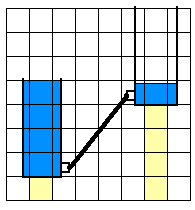
POTENTIAL ENERGY DIFFERENCE AS A GATE TO PERPETUAL ENERGY TRANSFERS
First we present a diagram of a system that brings more power output than the power needed to make it work:

The diagram represents a system of two connected water tanks on top of two elastic or hidraulic mechanisms in wich a little water level difference causes a big energy transfer, with the possibility of extracting more power from this energy transfer than the power needed to create the initial water level difference.
SYSTEM ELEMENTS:
The tanks: One tank has more radius than the other. Both tanks have an inner mechanism that can expand or reduce the radius a little. This mechanism needs a little power input to work, and it increase or reduce the radius of the tank just a bit, decreasing or increasing the water levels of the tanks when needed.
The Elastic or hidraulic mechanisms: They oppose to the weight of the tanks. When the tank is full of water, the elastic is compressed. When the tank is empty, the elastic is not compressed. The elastic mechanism keeps the water on the small radius tank always at the same level, independently of the water amount. The elastic compressions or expansions are a function of the tanks weights, just to keep the water level on the small radius tank always at the same value.
The Tanks interconnection: There is a pipe with S section connecting the tanks. The water level on one tank is never the same than on the other, so a water transfer will take place. Inside this pipe there is an electric turbine that will convert the water flow into electric power.
SYSTEM PERFORMANCE:
Let's suppose the tanks (A and B) are L=1m, and R=0.2m, and they can expand to R=0.22m activating the inner mechanism.
A Tank Radius |
A Water Height |
A Tank Weight |
A Elastic Length |
A Total Height |
B Tank Radius |
B Water Height |
B Tank Weight |
B Elastic Length |
B Total Height |
A - B Height Difference |
||
0.2 |
1 |
125.7 |
0.1 |
1.1 |
0.22 |
0.0829 |
12.6 |
1 |
1.0829 |
0.0171 |
||
0.2 |
0.7 |
88 |
0.4 |
1.1 |
0.22 |
0.3315 |
50.3 |
0.7 |
1.0315 |
0.0685 |
||
0.2 |
0.4 |
50.3 |
0.7 |
1.1 |
0.22 |
0.5801 |
88 |
0.4 |
0.9801 |
0.1199 |
||
0.2 |
0.1 |
12.6 |
1 |
1.1 |
0.22 |
0.8287 |
125.7 |
0.1 |
0.9287 |
0.1713 |
||
A Tank Radius |
A Water Height |
A Tank Weight |
A Elastic Length |
A Total Height |
B Tank Radius |
B Water Height |
B Tank Weight |
B Elastic Length |
B Total Height |
A - B Height Difference |
||
0.22 |
0.8287 |
12.6 |
1 |
1.0829 |
0.2 |
1 |
125.7 |
0.1 |
1.1 |
-0.0171 |
||
0.22 |
0.5801 |
50.3 |
0.7 |
1.0315 |
0.2 |
0.7 |
88 |
0.4 |
1.1 |
-0.0685 |
||
0.22 |
0.3315 |
88 |
0.4 |
0.9801 |
0.2 |
0.4 |
50.3 |
0.7 |
1.1 |
-0.1199 |
||
0.22 |
0.0829 |
125.7 |
0.1 |
0.9287 |
0.2 |
0.1 |
12.6 |
1 |
1.1 |
-0.1713 |
In the first 4 steps, 113 Kg of water goes from tank A to tank B without energy to apply. The transfer begins with a little height difference (0.0171m), and this height difference goes INCREASING through the transfer proccess (0.1713m) when it normally goes decreasing.
In the last 4 steps, the same 113 Kg of water goes from B to A again without energy to apply.
The only energy to apply is to change the full tank radius from 0.22m to 0.2m, increasing the water height inside this tank on 0.1713m.
The potential
energy of a water level is m*g*h.
The weight of the
new water level is: 0.1713*0.2^2*pi=21.526 Kg
The energy we need to apply to reduce the radio is equal to
the potential energy of the new water level: 21.526*9.81*0.1713=33.173
Also, we have to
increase the empty tank radius from 0.2m to 0.22m, decreasing the
water height inside this tank another 0.1713m.
The energy to do that is despicable, because we are reducing the
potential energy of the water on this tank.
When the water
transfer is triggered,the turbine transforms the kinetic energy
into electric energy.
The water flow speed is: v=sqrt(2*g*h)
Let's take h the medium height between tanks (because h changes
with time from 0.0171 to 0.171).
The water amount every second is: M=v*S,
with S the section of the tanks interconnection.
The time of transfer of 113 Kg of water is t=0.113/M
The kinetic energy on the turbine is: 1000*M/2*v^2=1000*sqrt(2*g*h)*S*g*h
so finally, the total energy in the water transfer
is: M/2*v^2*t=g*h*113
The energy we obtain from the transfer from one tank to the other is 9.81*0.0771*113=85.467
Then, the energy obtained on the electric turbine by the water transfers is 85.467/33.173= 2.576 the energy needed to change the water levels a little to trigger the proccess.